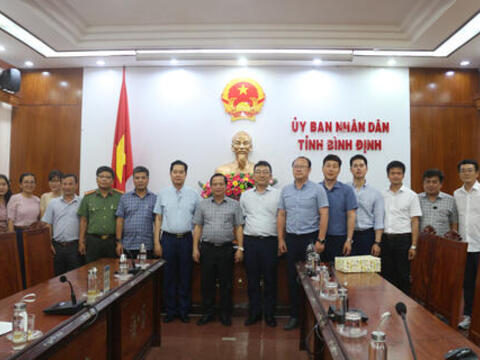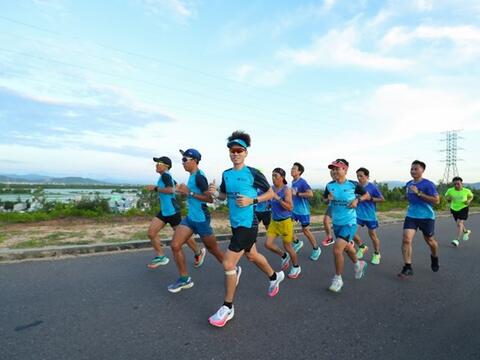| An Overview of Binh Dinh |
Binh Dinh, a coastal province situated in the south of Central Viet Nam, borders Quang Ngai province on the north, Phu Yen province on the south, Gia Lai province on the west and the East Sea in the east. It is 1,065 km south of Ha Noi, 686 km north of Ho Chi Minh City, 300 km south of Da Nang and 180 km east of Pleiku, the capital of Gia Lai province. Its natural land area is 6,039 km2. Its population is more than 1.5 million with more than 55% of labor force. The administrative structure includes 9 districts, 1 borough and Quy Nhon City. The average annual temperature is 27.1oC; average annual humidity is 78.4%; total annual sunshine is 2,354 hours; total annual rainfall is 2,209 mm.
Binh Dinh province has a special important geographical and economical location in regional and international connection and interaction. It is situated on the axis of road and rail routes from the North to the South, and is also the most convenient shortcut to the East Sea via National Highway 19 and Quy Nhon Seaport from the Highlands, Southern Laos PDR, Northeast Cambodia and Northeast Thailand. In the master plan for Binh Dinh socio-economic development to 2020, Binh Dinh is determined to become a province with a modern industry and one of the socio-economic development centers, positively contributing toward the development of key economic zones of Central Viet Nam and the whole country.
Phu Cat Airport is 30 km northwest of Quy Nhon City with flight routes to and from Ha Noi and Ho Chi Minh City. Dieu Tri Railway Station is one of the main railway stations. Apart from the national trains coming and going from Dieu Tri Railway Station, there is a local fast train coming from Quy Nhon to other provinces in the south Central and Ho Chi Minh City.
Quy Nhon International Seaport has a capacity for goods clearance of 7 million tons per annum and Thi Nai Seaport with 1 million tons per annum. The province is going to build Nhon Hoi Seaport of 12 million tons per annum; Dong Da Seaport of 1.4 million tons per annum; Quy Nhon Oil Seaport of 0.8 million tons per annum; Tam Quan Seaport of 0.96 million tons per annum.
There are four main rivers in Binh Dinh. They are Kon River, Lai Giang River, La Tinh River and Ha Thanh River. There are around 135 natural and man-made lakes with the total area of 38,000 ha. These are for agricultural irrigation purposes. Since the network of streams and rivers is mainly in the mountainous area, it is good for irrigation and hydropower development.
The forestry area is more than207,370 ha, including154,390 haof natural forest and52,980 haof re-forestation (34,624 hafor economic purposes). In addition, there are rattans, palm leaf, Lauraceae, and other forestry products, etc. These are material supplies for handicraft and consumer goods production.
There is a good variety of rare and precious minerals such as granite, titanium in the province. In addition, there are kaolin and clay mines mainly in Phu Cat, Tuy Phuoc and Tay Son districts for construction material production such as brick, tiles and ceramic tiles, etc., in the province.
There are five natural mineral water springs. Of which Phuoc My mineral water is of high quality for beverage production. Hoi Van hot water spring which has been exploited since 1976 is of accredited special standards for disease treatment and thermal electricity development, etc.
Binh Dinh has been focusing its resources for speeding up the planned construction of 8 industrial zones (not including the industrial zones inside Nhon Hoi Economic Zone); operating 40 of 62 industrial clusters; constructing major infrastructure to connect the adjacent regions of the north-south and east-west axis; developing the key economic sectors of its potentials such as forestry-agricultural-aquacultural product processing industries, construction material industry, leather and shoe making industry, garment industry, mechanic industry, deep-sea port, electric and electronic product manufacturing and assembling industry, electricity generation industry, development of tourism, maritime services, trade, financial services, banking, post & telecommunication, etc. There are 4,737 domestic enterprise entities and 87 others of foreign enterprises and branches.
Tourist activities in Binh Dinh are eventful and exciting. It is the land of martial arts, the homeland of King Quang Trung/Nguyen Hue. It is also the homeland and nurturing place of many famous people; the origin of Tuong and Bai Choi folklores. There are a variety of beautiful sceneries, beaches, traditional handicraft villages, and cuisines. It is the land of 14 Cham towers (8 groups), King Quang Trung Museum, the relics of Tay Son Revolution and many other historical and cultural relics. There are more and more tourists visiting and spending their relax time in Binh Dinh. Some of the enterprises are investing in the upgrading of the infrastructure, enhancing service quality and connecting to domestic and international tours.
There are sufficient and efficient services in postal and telecommunication. The local banking system provides all the banking services in both Viet Nam Dong and other foreign currencies.
Education and vocational training is developing in infrastructural scale, scope and training quality. The socialization of education is sped up and diversified in types of ownership, forms of training better meeting the needs of education and human resource development.
The local health care services have met the health care needs of people from the province and the region. Investment has been continuously on medical equipment and improving ethical attitude and professional skills of the health care work force.
With the good geographical, economical and infrastructural conditions together with the socio-economical promotion mechanisms and policies, promotion policies on industrial investment and development, Binh Dinh has all the adequate conditions for economic development in general and industrial development specifically in the future.

 Tiếng Việt
Tiếng Việt  Print the article
Print the article






